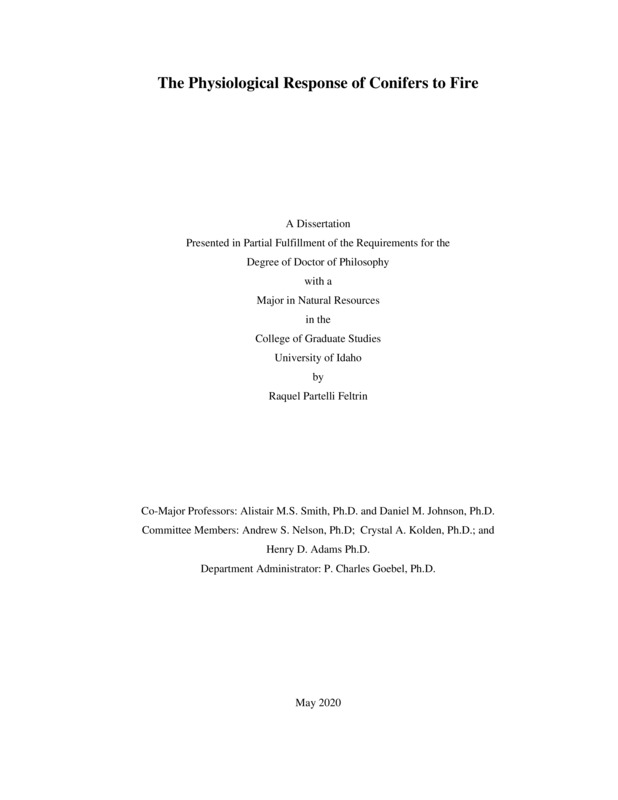The Physiological Response of Conifers to Fire
Partelli Feltrin, Raquel. (2020-05). The Physiological Response of Conifers to Fire. Theses and Dissertations Collection, University of Idaho Library Digital Collections. https://www.lib.uidaho.edu/digital/etd/items/partellifeltrin_idaho_0089e_11865.html
- Title:
- The Physiological Response of Conifers to Fire
- Author:
- Partelli Feltrin, Raquel
- ORCID:
- 0000-0002-5076-8515
- Date:
- 2020-05
- Keywords:
- fire hydraulic conductivity non-structural carbohydrates Pinus ponderosa sapling mortality tree physiology
- Program:
- Natural Resources
- Subject Category:
- Forestry
- Abstract:
-
One of the grand unknowns of ecosystem science is how fire kills trees. Answering this question is critical to parameterize climate-vegetation models given the observed changes in global fire regimes, the feedbacks between fire and forests in the global carbon cycle, and the potential role of forest management in moderating anthropogenic climate change. In this dissertation I conducted three studies using Pinus ponderosa saplings burned under controlled conditions to improve the understanding how fire effects on tree physiology. First, I assessed the impact of two fire intensities on sapling mortality under two water status pre-fire (well-watered and drought-stressed). The results showed that saplings under drought-stress pre-fire were more vulnerable to mortality when exposed to low fire intensities. However, 100% of mortality was observed regardless of the pre-fire water status when saplings were exposed to high fire intensity. Thus, the data also suggest that there is a fire intensity threshold where the pre-fire water stress can have a significant influence on sapling mortality. Second, we investigated the short (one-day post-fire) and long-term (21-months post-fire) effects of fire on sapling water transport. In the short-term, fire did not have impact on sapling xylem hydraulic conductivity or were more vulnerable to drought-induced embolism. However, in the long-term, saplings were more vulnerable to cavitation. But no damage in the xylem conduits cell walls were observed. Thus, it was hypothesized that the new traumatic xylem formed in the edges of the fire scar and the pre-fire xylem clogging with resin could be responsible for increasing vulnerability to cavitation in these plants. Lastly, I evaluated the impact of a lethal fire intensity on sapling hydraulic conductivity and non-structural carbohydrates periodically for 28-days post-fire. Hydraulic conductivity was not affected any day. This confirmed the results found in the second study. Fire caused a decline in total NSC in burned plants compared with unburned saplings, but it was significantly only 28-days post-fire. The results suggest that tree mortality from fire is likely not due to hydraulic failure but may be related to carbon imbalance.
- Description:
- doctoral, Ph.D., Natural Resources -- University of Idaho - College of Graduate Studies, 2020-05
- Major Professor:
- Smith, Alistair M.S; Johnson, Daniel M
- Committee:
- Kolden, Crystal A; Adams, Henry D; Nelson, Andrew S
- Defense Date:
- 2020-05
- Identifier:
- PartelliFeltrin_idaho_0089E_11865
- Type:
- Text
- Format Original:
- Format:
- application/pdf
- Rights:
- In Copyright - Educational Use Permitted. For more information, please contact University of Idaho Library Special Collections and Archives Department at libspec@uidaho.edu.
- Standardized Rights:
- http://rightsstatements.org/vocab/InC-EDU/1.0/

